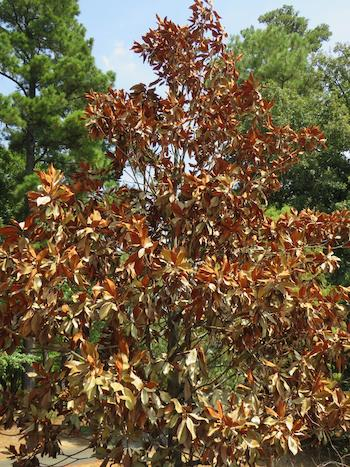
Many shade trees have suffered during the 2023 drought and need deep soaking.
September 12, 2023 - During the scorching heat and arid conditions that often accompany East Texas summers, our beloved shade trees face a significant challenge in maintaining their health and vigor. As guardians of beauty and cooler temperatures, these trees need our thoughtful care to withstand the trials of drought. In this article, we delve into the art and science of watering shade trees during these challenging times.
Shade trees provide more than just aesthetic value. They offer shade, reduce energy costs, and provide havens for wildlife. In the face of drought, ensuring their well-being becomes more important beginning with proper watering practices.
Imagine a slow, steady rain—the kind that soaks the ground and leaves a lasting impact. This is the kind of watering your shade trees need. A deep, slow soak encourages the roots to grow deeper into the soil, creating a robust and resilient foundation for the tree. Use a soaker hose or a drip irrigation system to provide a gradual and consistent flow of water directly to the tree's root zone. I often set up a hose-end sprinkler and run it for two hours per tree, once a week during a drought. Others turn the faucet to a trickle and leave beneath the tree all night.
The drip line, the area directly below the outermost edge of a tree's canopy, is where most of a tree's active roots reside. When watering, focus on saturating this critical region. Place your watering system around the drip line, ensuring that the moisture penetrates the soil deeply and reaches the roots that need it most.
Mulch, that unsung hero of gardening, can make a world of difference in conserving soil moisture and protecting tree roots. Apply a layer of course organic mulch, such as compost, wood chips, bark, or pine straw around the base of your shade tree. This acts as a natural insulator, reducing water evaporation and keeping the soil cooler. Remember to keep the mulch a few inches away from the tree trunk to prevent rot.
One simple yet effective way to determine whether your tree needs water is the finger test. Gently dig a few inches into the soil near the tree's root zone. If the soil feels dry at this depth, it's time to water. However, if it's still moist, hold off on watering for a bit longer.
Different tree species have varying water requirements. Native trees tend to be more adapted to local conditions, making them better suited to survive droughts. Non-native trees (particularly those from southeast Asia, like Japanese maples) might need a bit more care. Research the specific needs of the shade trees in your yard and tailor your watering regimen accordingly.
While our focus is on preserving the health of our shade trees, it's also crucial to be water-wise. Collect rainwater in barrels or cisterns during wet spells to use during dry periods. Avoid overwatering, as this can lead to shallow root systems and weakened trees with rotted roots.
During an East Texas drought, our shade trees depend on us for their survival. By practicing these watering techniques, we can ensure their longevity and the continuation of their cooling shade for generations to come. Remember, a little care goes a long way in preserving these natural wonders in our urban environments.
Greg Grant is the Smith County horticulturist for the Texas A&M AgriLife Extension Service. He is the author of Texas Fruit and Vegetable Gardening, Texas Home Landscaping, Heirloom Gardening in the South, and The Rose Rustlers. You can read his “Greg’s Ramblings” blog at arborgate.com and read his “In Greg’s Garden” in each issue of Texas Gardener magazine (texasgardener.com). More science-based lawn and gardening information from the Texas A&M AgriLife Extension Service can be found at aggieturf.tamu.edu and aggie-horticulture.tamu.edu.








